I.
INTRODUCTION
A computer is composed of three main
components, being the Central Processing Unit (CPU), Memory Unit and Input/Output(I/O).
Memory content is defined by the user depending on the application. Programs
designed to be executed by the CPU need to be stored in memory for the CPU to
access and execute. This is done by storing the program instructions on a
memory section, which the CPU accesses sequentially during the execution of the
program. Program data, usually referred to as variables, are also stored in
memory and accessed by the CPU in the same manner. Computer architecture
defines a data unit named word which
represents the size of a single unit of information. The unit size is usually
tailored to the application. Most modern computer architectures [1] have word sizes larger than one byte, being 4 bytes (32 bits) and 8
bytes (64 bits) the more common. Some computer architectures, in particular
Harvard-based ones, define different memory ranges to differentiate between
program instructions and program data. These ranges need to be known in order
to properly use the computer. This information is usually represented on a
memory map which lists the ranges where a program instructions and data can be
stored. The memory addressing is part of the computer architecture and
virtually all computer architectures [2] use byte addressing. In essence, byte addressing allows the user to
reference a single byte inside a word.
Nevertheless, memories are organized as block arrays and are meant to be
accessed one block at a time. The block size is related to cache memory line
size [3], in particular L1.
So even though CPUs support byte addressing, the program information (being
instruction or data) is usually word aligned, so much so that some CPU
architectures enforce a restriction preventing memory accesses that cross the word boundary. These types of accesses
are usually referred to as unaligned or misaligned accesses.
In [3] the authors study the impact of different unaligned
memory accesses on different x64 ISA (instruction set architecture)
instructions. Depending on the boundary crossed the time penalty can be up to
1800%.
The RISC-V is an open standard
instruction set architecture that is not bound to a particular implementation [4]. This means that while the computer
architecture is standardized and clearly defined, manufacturers have no
restrictions on how to implement the ISA. While this gives an enormous amount
of freedom to the designer it can create fragmentation among different
implementations of the same ISA [5]. Being an open architecture RISC-V allows microarchitecture changes to
improve security while maintaining the base instruction set compatibility.
This paper studies the
microarchitecture differences within memory access alignment in three different
RISC-V CPUs. Although the three CPUs implement the same basic RV32I instruction
set as a minimum, some implement a more complete RV32IMAC set including integer
multiplication/division, atomic access and compressed instructions. The focus
of the paper is comparing how the three handle
misaligned load access to data memory. As a result, we propose a simple code to
handle misaligned loads for word size
data, both in RV32I and RV32IMAC sets. A benchmark is performed to measure the
execution time penalty.
It is important to highlight that
most compilers will try to prevent misaligned access to memory. One known case
is the GCC [6] compiler which adds padding to data
structures in order to keep load access to the data structure element aligned.
Even though this will prevent misaligned access, the padding added to the data
structure consumes memory. On CPU implementations designed for embedded systems
and not general purpose computers memory is usually
constrained and using padding in data structures will waste this resource.
II. BACKGROUND
A. RISC-V
The base RISC-V ISA [7] is a fixed 32 bit
instruction length. However, it is designed to be extended to a variable length
set using 16 bits parcels. Therefore, instruction alignment needs to be
naturally aligned to the 16 bit parcel size. If the
implementation is restricted to the basic RV32I set, then a 32
bit natural alignment is needed for instructions, although it is very
common to find RV32IC which supports compressed instructions changing the
requirement to a 16 bit natural alignment. In fact, the macro-op fusion
benefits [8] from using the compressed
instructions to achieve better performance than other ISAs like x86 or ARM.
Data access on the other hand is
byte addressed and there are no restrictions by the ISA in terms of alignment.
The authors describe that for best performance data access should be naturally
aligned with the data size. This means that words (loaded with LW) should be
aligned to 32 bits and half words (loaded with LHW or LHU) should be aligned to
16 bits. Even though this is suggested for best performance, it is ultimately
up to the chip designer to support misaligned access. The RISC-V ISA does not
impose a restriction on the microarchitecture, so chip designers are free to
choose to support it or not. Nevertheless, the ISA defines a trap mechanism to
emulate the access in software. This means that it is ultimately possible to
support these types of misaligned access but with a time penalty.
B. Compilers
A typical compiler like GCC is
normally aware of the microarchitecture implementation allowing the programmer
to remain ignorant about it. In the case of RISC-V, there is a set of registers
accessible using the CSR* instructions which describe the microarchitecture.
The misa
register will describe which of the extensions the CPU supports. Therefore, it
is possible for a compiler to prepare code for several microarchitectures and
select the correct one during runtime. Unfortunately, this will create bloated
binaries [9] which are not memory efficient on
memory constrained devices like microcontrollers. A clear example of this is
the M extension. This extension provides hardware implementation for multiply
and divide instructions which should be faster than a software implementation.
Hence the compiler can prepare the code to detect if the M extension is
supported during runtime and implement a software emulation alternative in case
it does not. To facilitate this process the RISC-V architecture provides traps
for invalid instructions. This would allow the compiler to provide a trap
handler that would handle the missing instructions on the basic RV32I set.
There is of course a penalty for this but other than the trap handler the
original code remains the same.
The same technique can be used to
handle other faults related to the microarchitecture. In this paper a proposed
software emulation for a misaligned load is provided.
C. Data Structures
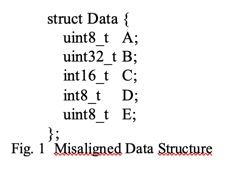
It is normal for programmers to
group related information using data structures. The C programming language
struct is a good example of this. Looking at Figure 1, the data structure is
composed of an 8 bit unsigned integer named A, a 32
bit unsigned integer named B, a 16 bit signed integer named C, an 8 bit signed
integer named D and finally an 8 bit unsigned integer named E.
If the programmer instantiates an
element with this data structure the compiler will be aware that the access to
certain elements will be misaligned in 32 bits systems [10]. If the structure is stored on a byte addressing
computer in a way that naturally aligns the first element (A), it will produce
a misaligned access to the B and C elements.
A programmer that is aware of the
microarchitecture limitations has the option to arrange the data in a way to
force natural alignment for the elements that are bigger than 8 bits. So, Figure
2 would be a possible re-ordering of the original structure in a way that all
access to the structure elements are naturally
aligned.
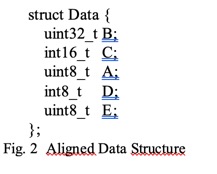
Unfortunately requiring this change
would be cumbersome to the programmer since it needs to manually align the
elements of the data structure, but it's still not good enough. The
re-arrangement will work for a single instance of the structure assuming the
instance is stored in a naturally aligned address but since the number of bytes
composing the structure is odd, it will not allow saving two consecutive
instances like an array. The second instance will be misaligned.
For this reason, compilers will not
require programmers to naturally align elements inside a structure and will
provide a solution to the alignment access by adding padding to the structure.
On Figure 1, the compiler will reserve three consecutive bytes after element A
effectively expanding A to be 32 bits. That way the structure is now naturally
aligned for all elements access but now it uses 12 bytes instead of the
original 9 bytes. This is a +33% increase penalty to keep alignment.
Furthermore, if the structure would be composed only by element A and B, the
added padding would increase the original structure to a +60%.
Compilers provide ways to restrict
padding by forcing the data to be packed, which does not add any padding, but
it does not enforce alignment. It is up
to the programmer to choose whether to save memory space or improve speed by
avoiding misaligned access which might incur in time penalties.
III. RELATED WORK
The Linux kernel recently added
support for software emulated misaligned accesses [11], but this implementation requires running the Linux
kernel which is not always an option specially on systems that have no MMU and
have fixed limited memory. Microcontrollers like the ones studied on this paper
usually implement software in bare-metal or using a RTOS. The provided code in
this paper can be easily adapted to these chips without imposing a full Linux
kernel implementation.
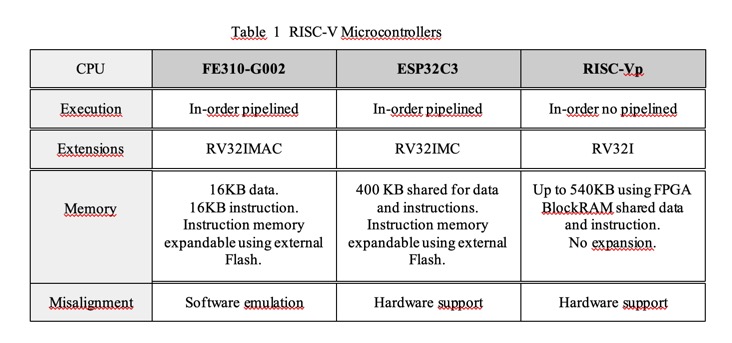
The authors in [12] study the effects of misaligned memory access in
microcontrollers but it is not restricted to RISC-V. Their study also includes
ARM and MIPS architectures. Their study is restricted in some cases to byte
access since not all platforms allow misaligned access for words. This paper
focuses on word load penalty when address is misaligned and provides software
emulation when hardware does not support this type of access.
Misaligned accesses become important
based on [3] Heap randomization can be improved
in architectures that support misaligned accesses.
IV. EVALUATION
Three different RISC-V
microarchitectures were studied in terms of their respective misaligned loads.
All three processors are oriented to microcontroller applications,
therefore memory is usually fixed size and as a scarce resource it is important
to maximize its usage. Hence using padding in data structures is not
recommended. Table 1 represents the instruction set extensions, memory size and
microarchitecture details of the three processors.
A.
FE310-G002
This RISC-V microcontroller [13] only supports software emulated
misaligned loads of words. The code present in Figure 3 shows how to force a
misaligned load using pointers.
The C compiler translates the
misaligned load of pWord pointer into loadVariable with the ASM listed on Figure 4.
The middle ASM instruction in the
group is the actual misaligned load. Since it's a full 32 bit
word load with offset 0 based on the address pointed by a5 into a5, this
instruction can be compressed into 16 bits.
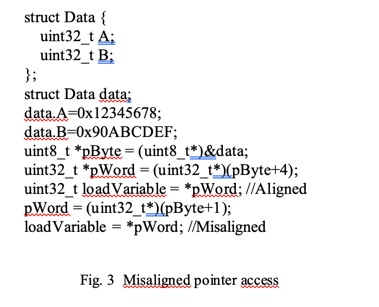
In order to test time penalties, a
trap handler was written to software-emulate the misaligned access. The code
for the handler is provided in [14]. This handler only supports LW instructions, although it can be easily
extended to handle LH and LHU misaligned access as well. The handler supports
both RV32I and RV32IC extensions, detecting at runtime if the offending
instruction is LW or C.LW (compressed LW).
The handler reads the mcause register
to check if it is a load alignment issue. If that is the case, then it recovers
the address of the offending instruction from the mepc register. Since the
instruction can be either LW or C.LW, it can be
aligned to 32 or 16 bits, so the handler supports the possible misaligned
instruction access. Upon reading the instruction it calculates the return
address for the trap (done later with mret) and the destination register for the load. In order to
emulate the access, several registers are temporarily used, and their previous
content is saved on the stack. Upon return the original content of those will
be recovered, except for the destination register of the misaligned access
which should have the misaligned data. This is true for all cases except when
the destination register is the stack pointer itself. In this case, there needs
to be an extra scratch register or fixed memory location used to store the
misaligned value prior to calling mret. In the case of this handler, it will scratch the T5
register, but this can be modified to use a fixed memory location and avoid
using T5.
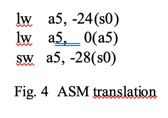
The software emulation executed 92
extra instructions for the access listed on Figure 4. This number of extra
instructions will depend on how the original offending instruction is coded,
what type of misalignment it performs and most important what is the
destination register, being the higher ones from x0 to x31 the worst ones.
B. ESP32C3
This RISC-V microcontroller [15] supports hardware misaligned loads.
There is no need to provide a trap handler since the hardware supports the
misaligned access. Since ESP32C3 has a pipelined microarchitecture with data
and instruction caches, using the cycle performance counter (CSR 0x7e2 for this
chip) might yield different values depending on the pipeline stage and cache
state. Therefore, a loop doing 100 aligned access followed by another loop with
100 misaligned access were executed while saving the cycle performance counter.
The results yielded 807 cycles for aligned access and 1906 cycles for the
misaligned ones. These numbers include the loop instructions and performance
counter access overhead but since it is the same overhead on both loops the
comparison is still valid. The misaligned access incurs a 137% penalty.
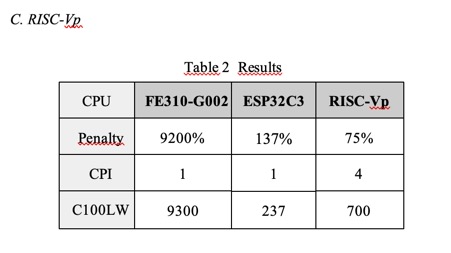
C. RISC-Vp
This RISC-V implementation [16] also supports hardware misaligned
loads. Since this microarchitecture was designed as an academic example of a
RISC-V implementation it is possible to predict the penalties in misaligned
access.
A proper aligned load uses 4 clock
cycles while a misaligned load consumes 7 clock cycles. This is a 75% penalty
when compared with an aligned load. This microarchitecture executes on a fixed
clock per instruction since it has no pipeline and no cache, therefore there is
no need to execute loops or use performance counters.
V. CONCLUSIONS
Table 2 shows that software
emulation can result in a big time penalty versus the
hardware implementation. The penalty for FE310-G002 is estimated since the trap
handler efficiency varies depending on the offending load. Both LW and C.LW were tested. The CPI (clocks per instruction)
represents the non-pipelined architecture of RISC-Vp
with a fixed 4 clock per instruction. The CPI listed for FE310-G002 and ESP32C3
is also estimated since it would depend on the pipeline state depending on the
code being executed but the goal for the pipeline would be one clock per
instruction.
Even though RISC-Vp
has a lower time penalty than ESP32C3 which also supports hardware misaligned
loads, ultimately the number of clocks per 100 misaligned loads (C100LW) ends
up being less for ESP32C3 due to the pipeline implementation.
The result clearly indicates that
software emulation of misaligned load can incur severe time penalties affecting
performance. Systems that require misaligned access should try to select a
microarchitecture that can perform these without software emulation.
The provided sample code [14] can be expanded to support
misaligned stores. This code is a good example of software emulation for
missing microarchitecture features proving that RISC-V was designed in a way
that simpler microarchitectures can execute code for more complete
implementations. In this test scenario the FE310-G002 was limited in terms of
misaligned access but this limitation can be overcome via software emulation at
a high time penalty.
VI. REFERENCES
[1] J. L. Hennessy and D. A. Patterson, Computer Architecture: A
Quantitative Approach Fifth Edition. 2007.
[2] D. M. Harris and S. L. Harris, Digital design and computer
architecture, 2nd edition. 2012. doi: 10.1016/C2011-0-04377-6.
[3] D. Jang, J. Kim, M. Park, Y. Jung, H. Lee, and B. B. Kang,
“Rethinking Misalignment to Raise the Bar for Heap Pointer Corruption.” arXiv, 2018. doi:
10.48550/ARXIV.1807.01023.
[4] K. Asanović and D. Patterson, “RISC-V: An Open Standard for
SoCs | EE Times,” EE Times, 2014.
[5] Agam Shah, “RISC-V takes steps to minimize fragmentation”
https://www.theregister.com/2022/04/01/riscv_fragmentation/, Apr. 01, 2022.
[6] R. M. Stallman and T. G. D. Community, “Using the GNU Compiler
Collection,” Development, vol. 2. 2012.
[7] A. Waterman et al., “The RISC-V instruction set manual,” Volume I:
User-Level ISA’, version, vol. 2, 2014.
[8] C. Celio, P. Dabbelt, D. A.
Patterson, and K. Asanović, “The Renewed Case for the
Reduced Instruction Set Computer: Avoiding ISA Bloat with Macro-Op Fusion for
RISC-V.” arXiv, 2016. doi:
10.48550/ARXIV.1607.02318.
[9] A. Singh, Mac OS X Internals: A Systems Approach (paperback).
Addison-Wesley Professional, 2006.
[10] Daniel Lemire, “Data alignment for speed: myth or reality?,” https://lemire.me/blog/2012/05/31/data-alignment-for-speed-myth-or-reality/,
May 31, 2012.
[11] Damien Le Moal, “[v2,1/9] riscv:
Unaligned load/store handling for M_MODE”
https://patchwork.kernel.org/project/linux-riscv/patch/20200312051107.1454880-2-damien.lemoal@wdc.com/,
Mar. 12, 2020.
[12] M. Hubacz and B. Trybus, “Data
Alignment on Embedded CPUs for Programmable Control Devices,” Electronics
(Basel), vol. 11, no. 14, 2022, doi:
10.3390/electronics11142174.
[13] SiFive Inc, “SiFive FE310-G002
Manual v1p4,” 2019.
[14] Edgardo Gho, “RISC-V Traps,”
https://github.com/edgardogho/RISC-V-Traps, Jul. 18, 2022.
[15] Espressif Systems, “ESP32-C3 Series Datasheet,” 2022.
[16] Edgardo Gho, “RiscVP,”
https://github.com/edgardogho/RiscVP, Mar. 04, 2021.